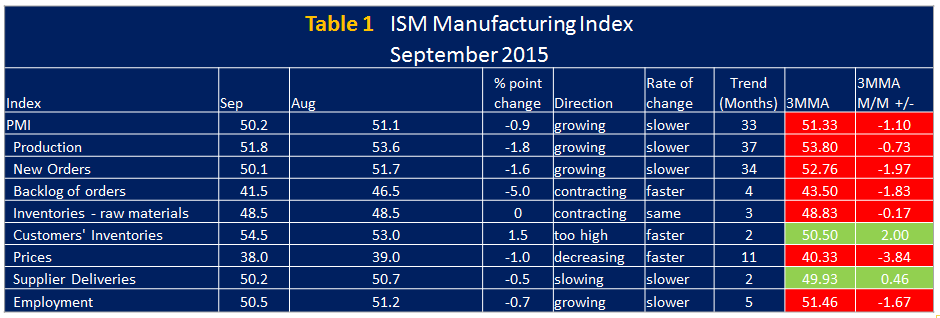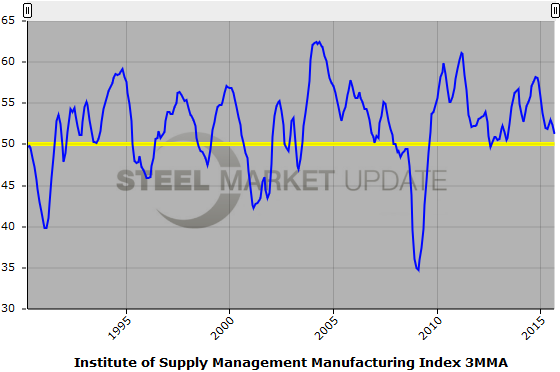Economy

ISM Manufacturing Index Decreases in September
Written by Sandy Williams
October 1, 2015
The September Institute of Supply Management (ISM) PMI registered 50.2 percent, a decrease of 0.9 percentage points from the 51.7 percent reading in August. The PMI is at its lowest point since May 2013 when it registered 50.1 percent.
The three month moving average has been see-sawing since June when it gained points after seven months of decline. The September PMI is at a 3MMA of 51.33, losing 1.1 points from August’s 3MMA of 52.43.
Production and new orders are still growing but at a slower pace. Backlogs and prices are decreasing at a faster rate. Manufacturers saw no change in raw material inventory in September but customer inventories were seen as too high.
The press release from ISM follows:
“(Tempe, Arizona) — Economic activity in the manufacturing sector expanded in September for the 33rd consecutive month, and the overall economy grew for the 76th consecutive month, say the nation’s supply executives in the latest Manufacturing ISM® Report On Business®.
“The report was issued today by Bradley J. Holcomb, CPSM, CPSD, chair of the Institute for Supply Management® (ISM®) Manufacturing Business Survey Committee. “The September PMI® registered 50.2 percent, a decrease of 0.9 percentage point from the August reading of 51.1 percent. The New Orders Index registered 50.1 percent, a decrease of 1.6 percentage points from the reading of 51.7 percent in August. The Production Index registered 51.8 percent, 1.8 percentage points below the August reading of 53.6 percent. The Employment Index registered 50.5 percent, 0.7 percentage point below the August reading of 51.2 percent. Backlog of Orders registered 41.5 percent, a decrease of 5 percentage points from the August reading of 46.5 percent. The Prices Index registered 38 percent, a decrease of 1 percentage point from the August reading of 39 percent, indicating lower raw materials prices for the 11th consecutive month. The New Export Orders Index registered 46.5 percent, the same reading as in August. Comments from the panel are mixed with some concern about the global economy and customer confidence.”
“Of the 18 manufacturing industries, seven are reporting growth in September in the following order: Printing & Related Support Activities; Textile Mills; Furniture & Related Products; Food, Beverage & Tobacco Products; Miscellaneous Manufacturing; Paper Products; and Nonmetallic Mineral Products. The 11 industries reporting contraction in September — listed in order — are: Primary Metals; Apparel, Leather & Allied Products; Petroleum & Coal Products; Wood Products; Electrical Equipment, Appliances & Components; Machinery; Computer & Electronic Products; Fabricated Metal Products; Plastics & Rubber Products; Transportation Equipment; and Chemical Products.”
Respondent’s comments included the following:
– “Revenues and profits in our industry continue to [be] impacted by low crude and gas prices.” (Petroleum & Coal Products)
– “North American business steady. International business trending bearish.” (Chemical Products)
– “High value of dollar is affecting global procurement pricing.” (Computer & Electronic Products)
– “Concerns about China downturn and its effect on our consumer confidence.” (Fabricated Metal Products)
– “Overall business is slowing. Consumers are nervous. Not sure what is coming next.” (Transportation Equipment)
– “The orders from customers seem to be slowing a bit from the first part of the year. We have promises but not actual Purchase Order numbers.” (Nonmetallic Mineral Products)
– “Sales revenue and profitability improving slowly. Getting close to 2015 budget/sales plan. Not seeing consistent trends up or down.” (Electrical Equipment, Appliances & Components)
– “Continue to feel impact of oil and gas market slowdown. Aerospace demand has also been slower than expected. Consumer Electronics not robust.” (Primary Metals)
The Manufacturing ISM Report On Business is published monthly by the Institute for Supply Management, the first supply institute in the world. Founded in 1915, ISM exists to lead and serve the supply management profession and is a highly influential and respected association in the global marketplace. ISM’s mission is to enhance the value and performance of procurement and supply chain management practitioners and their organizations worldwide. This report has been issued by the association since 1931, except for a four-year interruption during World War II. The report is based on data compiled from purchasing and supply executives nationwide. Membership of the Manufacturing Business Survey Committee is diversified by NAICS, based on each industry’s contribution to gross domestic product (GDP). The PMI is a diffusion index. Diffusion indexes have the properties of leading indicators and are convenient summary measures showing the prevailing direction of change and the scope of change. A PMI reading above 50 percent indicates that the manufacturing economy is generally expanding; below 50 percent indicates that it is generally declining. A PMI in excess of 42.2 percent, over a period of time, indicates that the overall economy, or gross domestic product (GDP), is generally expanding; below 42.2 percent, it is generally declining. The distance from 50 percent or 42.2 percent is indicative of the strength of the expansion or decline. With some of the indicators within this report, ISM has indicated the departure point between expansion and decline of comparable government series, as determined by regression analysis.

Sandy Williams
Read more from Sandy WilliamsLatest in Economy

Steel groups welcome passage of budget bill
Steel trade groups praised the passage of the Big Beautiful Bill (BBB) in Congress on Thursday.

Industry groups praise Senate for passing tax and budget bill
The Steel Manufacturers Association and the American Iron and Steel Institute applauded the tax provisions included in the Senate's tax and budget reconciliation bill.

Chicago PMI dips 0.1 points in June
The Chicago Purchasing Managers Index (PMI) slipped 0.1 points to 40.4 points, in June.

Multi-family pullback drives housing starts to 5-year low in May
US housing starts tumbled in May to a five-year low, according to figures recently released by the US Census Bureau.

Architecture firms still struggling, ABI data shows
Architecture firms reported a modest improvement in billings through May, yet business conditions remained soft, according to the latest Architecture Billings Index (ABI) release from the American Institute of Architects (AIA) and Deltek.


